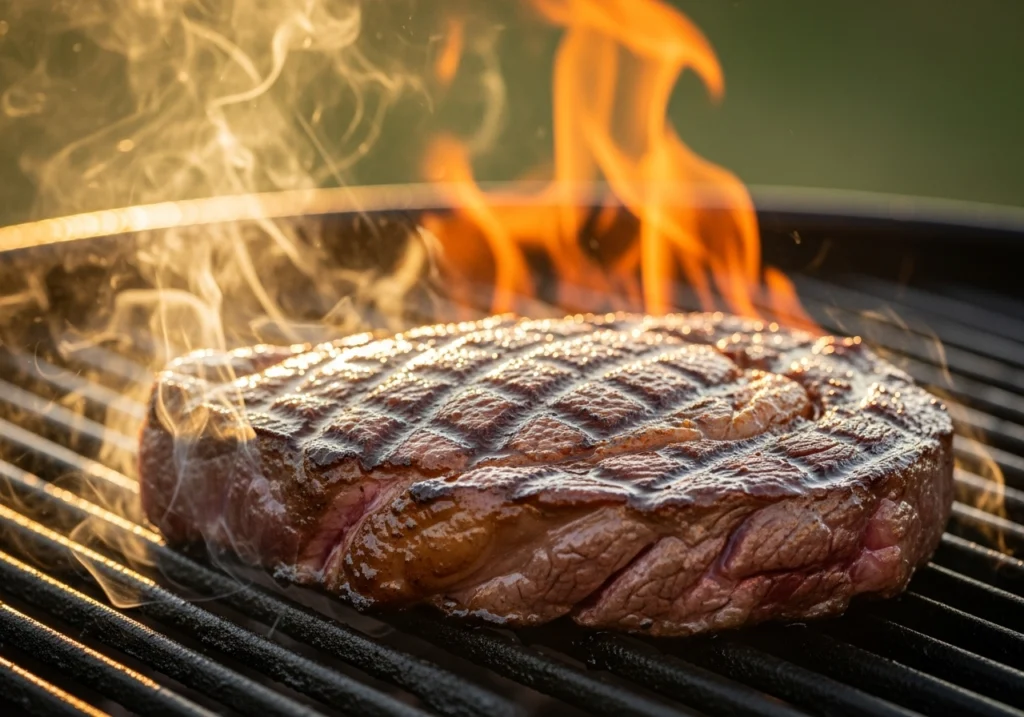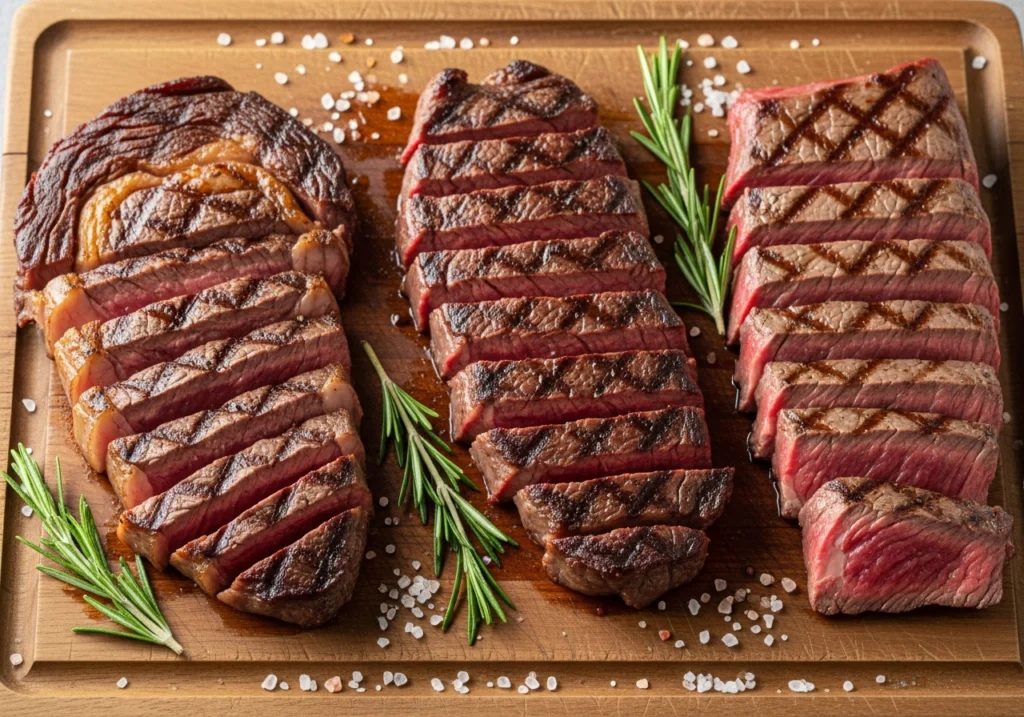Best Steak Cuts for Grilling: A Butcher’s Guide
I’ll never forget my first trip to a real butcher shop. I stood there staring at the meat case feeling completely overwhelmed. Ribeye, strip, sirloin, flank—they all looked like… well, red meat. I ended up pointing at something random and hoping for the best.
That night’s dinner? Pretty mediocre. Turns out I’d grabbed a tough cut that needed braising, not grilling.
Since then, I’ve learned that choosing the right steak cut for grilling makes all the difference between a jaw-aching chew-fest and that melt-in-your-mouth moment everyone raves about. And honestly, once you understand what makes each cut special, shopping for steak becomes way less intimidating.
Today I’m sharing everything I wish someone had told me back then—which cuts are worth the splurge, which ones are budget-friendly winners, and how to grill each one perfectly. If you want to put this knowledge into action, I’ve got tons of specific steak recipes that’ll walk you through the cooking process step-by-step.
What Makes a Great Grilling Steak?
Before we dive into specific cuts, let’s talk about what you’re actually looking for.
The best grilling steaks have three things going for them: good marbling (those white fat lines running through the meat), adequate thickness (at least 1 inch), and the right texture. Marbling keeps the steak juicy and adds flavor. Thickness gives you time to develop a crust without overcooking the inside.
According to the USDA grading system, Prime beef has the most marbling, followed by Choice, then Select. For grilling, I always go for Choice at minimum—it’s the sweet spot of quality and price for most home cooks.
Tender cuts from the loin and rib sections are your best bet for grilling. Tougher cuts from heavily-worked muscles (like shoulder or leg) need slow cooking methods to break down connective tissue.
The Premium Cuts
These are the splurge-worthy steaks that deliver incredible flavor and tenderness.
Ribeye Steak
This is my desert island steak. If I could only grill one cut for the rest of my life, ribeye would be it.
What makes it special: Ribeye comes from the rib section and has generous marbling throughout. That fat renders as it cooks, creating incredible flavor and keeping the meat super juicy. You’ll often see a big cap of fat on one side and sometimes a pocket of fat in the center (the “eye”).
Flavor profile: Rich, beefy, buttery. It’s the most flavorful common steak cut, period.
Best thickness: 1.5 to 2 inches. Thicker ribeyes let you get a great crust while keeping the inside medium-rare.
Grilling tips: High heat is your friend here. I sear mine over direct heat for 4-5 minutes per side, then move to indirect heat if needed. The fat content means occasional flare-ups—don’t panic, just move it temporarily. Let it rest for 10 minutes before cutting.
Price range: $15-25 per pound
New York Strip (Strip Steak)
This is what I grab when I want something luxurious but slightly less rich than ribeye.
What makes it special: Cut from the short loin, the strip has a nice fat cap on one edge but is leaner than ribeye throughout. It’s got a tighter grain and firmer texture while still being tender.
Flavor profile: Bold beef flavor without being fatty. Clean, pure beefiness with a satisfying chew.
Best thickness: 1 to 1.5 inches works perfectly.
Grilling tips: Because it’s leaner, you’ve got less margin for error. I pull mine at 130°F for medium-rare. Don’t skip seasoning that fat cap generously—it adds great flavor as it renders. Grill over high direct heat, about 4 minutes per side for a 1-inch steak.
Price range: $13-20 per pound
Filet Mignon
The fancy date night steak. It’s tender as butter but needs some help in the flavor department.
What makes it special: Cut from the tenderloin, filet mignon is the most tender steak you’ll find. Like, fork-tender. But it’s also very lean, which means less beefy flavor than ribeye or strip.
Flavor profile: Mild, delicate, buttery texture. It’s about tenderness more than bold flavor.
Best thickness: 2 inches minimum. These are thick medallions, and you want that luxurious cut.
Grilling tips: Here’s my trick—I wrap mine in bacon before grilling. Sounds cliché, but that bacon fat solves the lean meat problem beautifully. Otherwise, baste with butter constantly during cooking. High heat, quick sear, then move to indirect heat. Pull at 130-135°F. It needs a good rest—at least 5 minutes.
Price range: $20-35 per pound
The Value Cuts
These steaks won’t break the bank but still deliver great grilled flavor.
Flank Steak
My go-to when I’m feeding a crowd on a budget. Done right, flank steak is absolutely delicious.
What makes it special: This comes from the abdominal area, so it’s a tougher, leaner cut with pronounced grain. But it’s also got serious beefy flavor.
Flavor profile: Intensely beefy, slightly mineral. Really satisfying.
Best thickness: You don’t choose thickness here—flank steaks are naturally thin, about 1 inch or less.
Grilling tips: This is crucial—marinate it for at least 2 hours, grill it hot and fast over direct heat (5-6 minutes total for medium-rare), and ALWAYS slice it thin against the grain. I’m serious about that last part. Slice with the grain and you’ll be chewing forever. Against the grain, it’s tender and amazing.
Price range: $8-12 per pound
Sirloin Steak (Top Sirloin)
A solid weeknight steak that won’t drain your wallet.
What makes it special: Cut from the hip area, sirloin is leaner than ribeye but more affordable. Top sirloin specifically is the best section—more tender than bottom sirloin.
Flavor profile: Good beef flavor, firmer texture. Not as rich as premium cuts but still satisfying.
Best thickness: 1 to 1.5 inches.
Grilling tips: Don’t overcook this one—it gets tough past medium. I actually prefer sirloin at medium-rare (130-135°F). Season generously, use high direct heat, and give it a good 5-minute rest. Consider a compound butter on top when serving to add richness.
Price range: $7-11 per pound

Skirt Steak
The secret weapon for fajitas and steak salads, but criminally underrated for straight-up grilling.
What makes it special: From the diaphragm muscle, skirt steak is thin, intensely beefy, and has a loose grain. It’s similar to flank but even more flavorful and slightly more tender.
Flavor profile: The most intensely beefy flavor of any cut. Rich and mineral-forward.
Best thickness: Like flank, it’s naturally thin—usually under 1 inch.
Grilling tips: Screaming hot grill, 2-3 minutes per side max for medium-rare. Any longer and you’ll have shoe leather. Slice against the grain at an angle. Marinating helps but isn’t mandatory like with flank—skirt has enough flavor to stand alone with just salt and pepper.
Price range: $9-14 per pound
According to Serious Eats, these tougher, flavorful cuts actually benefit from the high heat of grilling when cooked quickly.
Quick Grilling Tips for All Cuts
Bring to room temp: Take your steak out 30-45 minutes before grilling. Cold steak = uneven cooking.
Season generously: I use about 1 teaspoon of kosher salt per pound, plus black pepper. Do this right before grilling.
Oil the steak, not the grates: Brush your steak with high-smoke-point oil (avocado, grapeseed). It prevents sticking better than oiling grates.
Create two zones: Set up direct high heat on one side, indirect lower heat on the other. This gives you flexibility.
Use a thermometer: Stop guessing. A $25 instant-read thermometer changed my grilling life.
Rest is mandatory: 5 minutes minimum for thin cuts, 10 minutes for thick ones. Those juices need to redistribute.
Common Grilling Mistakes
Mistake #1: Flipping constantly. Flip once. That’s it. Let the first side develop a proper crust before touching it.
Mistake #2: Cutting into it to check doneness. Every cut releases juice. Use a thermometer instead.
Mistake #3: Using lean cuts like strip or sirloin on high heat too long. These cuts dry out fast. Watch your temps carefully.
Mistake #4: Not accounting for carryover cooking. Your steak keeps cooking after you pull it. Remove it 5°F before your target temp.
FAQ
What’s the most forgiving cut for beginners?
Ribeye, hands down. The fat content gives you more margin for error—it stays juicy even if you slightly overcook it.
Can I grill thin steaks successfully?
Absolutely, but they need extremely high heat and very short cooking times. Skirt and flank steaks are perfect examples—2-3 minutes per side max.
Should I marinate expensive cuts?
No need. Ribeye, strip, and filet have enough natural flavor. Save marinades for tougher cuts like flank and skirt that benefit from the tenderizing.
What if I can only afford cheaper cuts?
Embrace flank, skirt, and sirloin! They’re delicious when cooked properly. The key is not overcooking them and slicing thin against the grain.
Final Thoughts
Learning these different cuts transformed my grilling game. Now when I’m at the butcher counter, I know exactly what I’m looking at and which cut matches my budget and dinner plans.
Start with one cut and master it. I’d recommend ribeye if you can swing it, or flank steak if you’re budget-conscious. Once you’ve nailed one, branch out and try the others. Before long, you’ll have a whole arsenal of grilling knowledge.
Now fire up that grill and make something incredible!
Happy grilling!
– Ellie

Quick Reference Guide
| Cut | Tenderness | Flavor | Price | Best For |
|---|---|---|---|---|
| Ribeye | Very Tender | Rich | $$$ | Special occasions |
| NY Strip | Tender | Bold | $$-$$$ | Date night |
| Filet Mignon | Most Tender | Mild | $$$$ | Luxury dining |
| Flank | Chewy* | Intense | $ | Fajitas, crowds |
| Sirloin | Moderately Tender | Good | $ | Weeknights |
| Skirt | Chewy* | Very Intense | $-$$ | Quick dinners |
*When sliced against the grain properly
